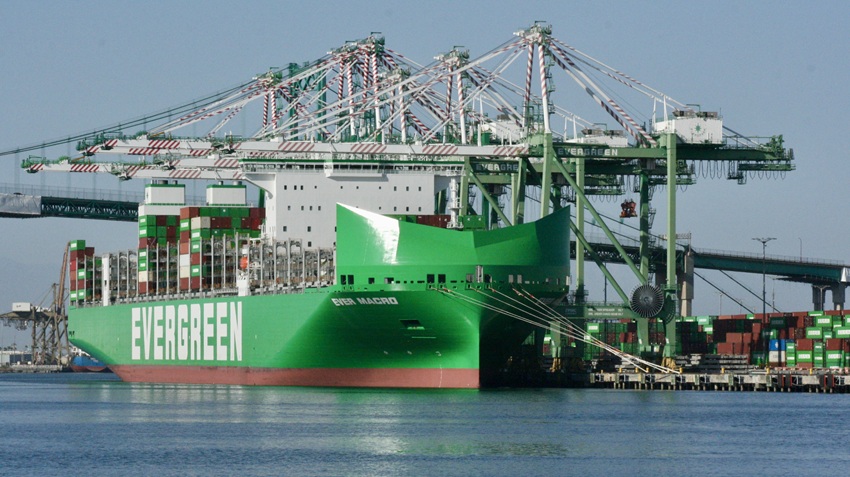West Coast Ports Eye Consumer Demand Weakened by ‘Whipsaw’ News Effect

The Port of Los Angeles expects calmer waters in the coming months as throughput drops. Photo by Eric Watkins.
U.S. West Coast ports inevitably feel the impacts of consumer spending, and this year is no exception. The difference this year, though, is the tariff-driven uncertainty that has caused a sharp rise in containerized cargo during the first quarter, but also a potentially sharp fall-off in throughput yet to come.
“We've been looking at record numbers just in general. Our year-to-date numbers for 2025 are running ahead of where we were last year by quite a bit,” says Mike Jacob, president of the Pacific Merchant Shipping Association (“PMSA”), which represents ocean carriers and marine terminal operators at ports along the West Coast.
The main container ports along the Pacific do indeed report generally higher figures for the first part of the year, but as Jacob notes, the key question among industry professionals in the region is “What comes next?” The answer has everything to do with consumers.
The Port of Los Angeles handled 842,806 twenty-foot equivalent units (“TEU”) in April, 9.4% more than last year. Over the first four months of the year, 3,346,853 TEU have crossed its dock, an uptick of 6.2% over the same period in 2024.
Port of Los Angeles Executive Director Gene Seroka attributed the positive numbers to a strong economy, high consumer confidence and the recent “push” by importers to bring cargo in ahead of today’s tariffs.
But that positive trend is not expected to last, Seroka said, noting that “moving forward – at least for the short term – we will see a softening of global trade during this period of elevated tariffs and uncertainty.”
That view was shared by Mario Cordero, chief executive at the neighboring Port of Long Beach, who noted that his facility is “now anticipating a 10% drop-off in imports in May” after moving the most containerized cargo of any American port in the first quarter of the year.
“Soon, consumers could find fewer choices and higher prices on store shelves and the job market could see impacts, given the continuing uncertainty,” Cordero said.
Farther to the north in California, Port of Oakland Maritime Director Bryan Brandes said container volume remained stable during the first four months of 2025 but that “uncertainty and high tariffs impacted our China volume.”
Oakland handled 185,499 TEU in April, marking a 14.7% decrease in overall cargo volume from March 2025, a slowdown it said was “driven by market uncertainty as well as softening demand in exports — both influenced by recent shifts in US trade policy.”
The news out of Washington state from the Northwest Seaport Alliance of Seattle (“NWSA”) and Tacoma was no less concerned about the sudden rises and falls in cargo throughput, which one official characterized as the “bullwhip” effect.
While March and April saw higher volumes year-over-year compared to 2024, a significant shift occurred in the second week of May 5 when, compared to the week before, the port saw a 30% drop in international import volumes and a 23% decline compared to the weekly average for the entire year.
"We understand that the public is anxious on the potential impacts of the tariffs and the rapid and unpredictable fluctuations and the major policy trade decisions happening at the White House,” said Toshiko Hasegawa, NWSA co-chair and president of the Port of Seattle Commission.
Seroka feels the same way about the unpredictability, which he says is the “biggest conversation point” he’s had in all of his recent meetings. “Every day and every week it's this whipsaw effect of information that's coming out of Washington related to trade policy.
“We're now up to about 57 different announcements since January alone,” Seroka said, adding that “even for the most seasoned professional in this business, it's a lot to keep up with.”
The whipsaw of information also affects consumer sentiment, according to a survey by the University of Michigan, which it said had “ebbed at the preliminary reading for May but turned a corner in the latter half of the month following the temporary pause on some tariffs on China goods.”
The uptick of 52.2 due to the positive report was a bit higher than a preliminary reading of 50.8 that was released two weeks ago. But the new reading is still one of the lowest ever recorded by the Michigan survey, in data going back to 1952.
“Given that consumers generally expect tariffs to pass through to consumer prices, it is no surprise that trade policy has influenced consumers’ views of the economy,” the Michigan survey said.
David Seif, chief economist for developed markets at Nomura, told The Wall Street Journal that tariff worries are the “overwhelming reason” why sentiment is near a historic low. “These are extraordinary news cycles, and tariffs are just so in people’s faces,” he said.
As a result of the turmoil, U.S. consumers have grown increasingly cautious in their spending habits as their spending growth slowed from a month-over-month pace of 0.7% in March to 0.2% in April, according to a May 30 report by the Bureau of Economic Analysis.
At the moment, predicting the future comes down to a matter of weighing the significance of two opposite sets of data: the hard data documenting the numbers from frontloading as companies stocked up ahead of tariffs, while the soft data appears to portend a collapse in demand as consumers anticipate tariff-driven price hikes.
Judging consumer demand is the name of the game when it comes to the supply chain industry, and right now it is anyone’s guess which way that demand will go in the coming months.
That is really the crux of the matter, according to PMSA’s Mike Jacob.
“We look at macro demand or how these trade lanes start impacting our ability to fill vessels and whether or not that justifies a string,” he says. “The real hard work is from the actual cargo owners and their customs brokers and freight forwarders.”
They are the ones, according to Jacob, “who have to actually try to calculate all this stuff, make real time decisions, and then make guesses about what their supply and demand is and their prices and all that stuff. I mean, that's the hard part.”
How many containerized units will cross the docks of U.S. West Coast ports in the months to come? Much will depend on the frequency of news coming out of the nation’s capital, keeping in mind that whipsaw effect on that all-important consumer sentiment and spending.
About the Author

Eric Watkins
hippalus@yahoo.com.
Eric Watkins is an independent writer, editor and analyst specializing in opportunity management for trade, supply chains, and critical infrastructure.
